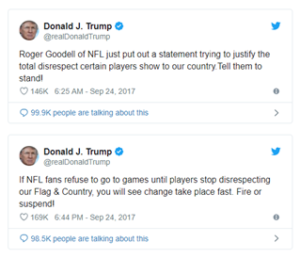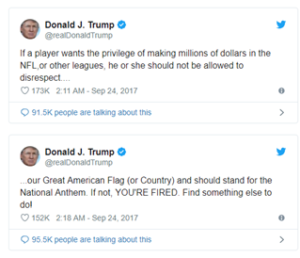For a long time, American Football has always dominated viewership in the US being the most watched event in sports and TV in general. The Super Bowl is one of the most anticipated events, along with its halftime show which gives fans spectacular performances that keep them clamoring for more year after year. The NFL has established itself in the TV industry, earning $14 billion in annual revenue highly due to advertisers who are willing to break the bank for commercials during games. However, in the past couple of years, the league is starting to see a steady decline in its viewership as many issues and controversies haunt them. Let’s take a look at some of the main issues and how they are negatively affecting the NFL’s viewership.
The Donald Trump effect
Late last year, we have witnessed the controversy involving Donald Trump and his criticism of the league over player’s protesting social injustice in the country, by kneeling during the performance of The Star Spangled Banner at the start of games. Donald Trump posted a tirade of tweets directed at players and the league, and how it was being handled by the NFL offices.


Colin Kaepernick, former quarterback for the San Fransisco 49ers was at the helm of this protest, stating “I am not going to stand up to show pride in a flag for a country that oppresses black people and people of color. To me, this is bigger than football, and it would be selfish on my part to look the other way. There are bodies in the street and people getting paid leave and getting away with murder.” Kaepernick was seen sitting or kneeling in the bench during the national anthem which received mixed reactions from the public. Some would consider Kap to be brave hero, as he uses his platform to fight for what he feels as injustice in the society. And on the other hand, he also received criticism from people who have the same sentiments as the president, and feel Kap is disrespecting the flag and the people who fought for the freedom of the nation.
As the saying goes “any publicity is good publicity”, apparently in this case that doesn’t apply as the league experienced a steeper decline in viewership after this controversy, as people who support or don’t support Trump, are angered by these players’ protests and refuse to support the league’s games. This season, the NFL was initially expected to enforce a policy on player conduct during the National anthem. But just hours before kick-off they announced they will not be enforcing any policy at all, and we see numerous players continue with their protest. The NFL will review this policy early in 2019, and their judgement to some may be commendable. However, this has already negatively affected the league and they are forced to make a compromise that protects players rights to freedom and also protects the business’ profitability.
The concussion dilemma
Another issue that the league is facing, is related to their concussion protocol that serves to protect players from brain injury. For years, the league has continued to deny the relationship of concussive brain injury and the sport of football, which was all put to bed by Dr. Bennet Omalu. He examined former Pittsburgh Steeler, Mike Webster and discovered a new disease called chronic traumatic encephalopathy, or CTE. In 2009, the league finally acknowledged the link between chronic brain damage and football, and has since dedicated resources to the research of brain damage, and implements rule changes to ensure the protection of players during games.
The issue with brain damage in the league, is that they are not able to put out a product that is as exciting and explosive when the concussion protocol wasn’t as restrictive. As stated in the protocol, players who potentially experience a concussion are escorted to the locker room wherein they will receive a thorough assessment and if deemed that they did suffer one they will no longer be allowed to return to the game, and will potentially miss a couple practices and games before they will be allowed back on the field. As a precaution to concussive injury, players and teams are then forced to run plays that are much safer to reduce the opportunity for impact and collision. This is much to the fans disappointment, as most fans watch the sport for its barbaric nature and explosiveness.
The risk of brain damage also affects the leagues scouting of new talent, as parents of players in high school and college start to discourage their children’s participation in the sport. This is a challenge faced by most contact sports like boxing and MMA, and now the NFL too. We are far from the days of leather helmets, so the league’s best bet is to develop equipment that allow players to be explosive while also being protected at the same time.
Rising stars from the dumps
Though TV ratings and viewership of the league is down, the revenue of NFL teams are on the rise. This can be attributed to the great performances of previously underperforming teams in small markets like the Tennessee Titans, Jacksonville Jaguars and Kansas City Chiefs, who have all had stellar performances in the post season last year. This would mean that these teams will be taking air time from teams who have a bigger following like the Dallas Cowboys, Green Bay Packers and Seattle Seahawks, all of whom are having a mediocre season. The NFL’s profits are dependent of these teams great performance, and as long as they continue to do so, the league is still pretty much stable.
A great example of this would be how Tom Brady and the Patriot’s comeback win over the Jaguars last season in the AFC Championship game, have saved TV networks profits from their commercial deals. Had the Jaguars faced the Eagles in the Superbowl, viewership wouldn’t be as strong even for the most anticipated event in the country. This is not to say that it is negative for smaller teams to succeed in the league, but might be a sign that the NFL is undergoing a reconstruction of its fan base, as these teams continue to make an impact on the league and these small markets grow and turn into cash cows.
